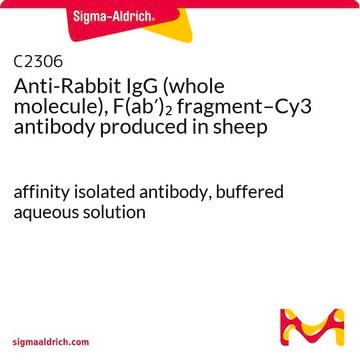F1262
Anti-Rabbit IgG (whole molecule), F(ab′)2 fragment–FITC antibody produced in goat
affinity isolated antibody, buffered aqueous solution
Sign Into View Organizational & Contract Pricing
All Photos(1)
About This Item
Recommended Products
biological source
goat
conjugate
FITC conjugate
antibody form
affinity isolated antibody
antibody product type
secondary antibodies
clone
polyclonal
form
buffered aqueous solution
technique(s)
indirect immunofluorescence: 1:40
storage temp.
2-8°C
target post-translational modification
unmodified
General description
Goat polyclonal anti-Rabbit IgG (whole molecule), F(ab′)2 fragment–FITC antibody binds all rabbit IgGs.
Immunoglobulins (Igs) are glycoprotein antibodies that modulate several immune responses. Rabbit IgGs against target proteins are often used as primary antibodies in various research applications. Thus, secondary anti-rabbit IgGs can be useful tools for the analysis of target proteins
Anti-Rabbit IgG (whole molecule), (F(ab′)2) fragment-FITC is specific for all rabbit immunoglobulins. The use of this product prevents background staining due to the presence of Fc receptors.
Anti-Rabbit IgG (whole molecule), (F(ab′)2) fragment-FITC is specific for all rabbit immunoglobulins. The use of this product prevents background staining due to the presence of Fc receptors.
Rabbit IgG is a plasma B cell derived antibody isotype defined by its heavy chain. IgG is the most abundant antibody isotype found in rabbit serum. IgG crosses the placental barrier, is a complement activator and binds to the Fc-receptors on phagocytic cells. The level of IgG may vary with the status of disease or infection.
Fluorescein isothiocyanate (FITC) is a fluorescein derivative (fluorochrome) used to tag antibodies, including secondary antibodies, for use in fluorescence-based assays and procedures. FITC excites at 495 nm and emits at 521 nm.
Fluorescein isothiocyanate (FITC) is a fluorescein derivative (fluorochrome) used to tag antibodies, including secondary antibodies, for use in fluorescence-based assays and procedures. FITC excites at 495 nm and emits at 521 nm.
Immunogen
Purified rabbit IgG
Application
Anti-Rabbit IgG (whole molecule), (F(ab′)2) fragment-FITC is suitable for use in flow cytometry.
Anti-Rabbit IgG (whole molecule), F(ab′)2 fragment–FITC antibody produced in goat has also been used for fluorescence labeling and immunocytochemistry.
Goat polyclonal anti-Rabbit IgG (whole molecule), F(ab′)2 fragment–FITC antibody may be used to detect and quantitate the level of IgG in rabbut serum and biological fluids by fluorescent techniques. It may also be used as a secondary antibody in assays that use rabbit IgG as the primary antibody. F(ab′)2 fragment–FITC antibody is useful when trying to avoid background staining due to the presence of Fc receptors.
Physical form
Solution in 0.01 M phosphate buffered saline, pH 7.4, containing 1% bovine serum albumin and 15 mM sodium azide.
Disclaimer
Unless otherwise stated in our catalog or other company documentation accompanying the product(s), our products are intended for research use only and are not to be used for any other purpose, which includes but is not limited to, unauthorized commercial uses, in vitro diagnostic uses, ex vivo or in vivo therapeutic uses or any type of consumption or application to humans or animals.
Not finding the right product?
Try our Product Selector Tool.
Storage Class Code
10 - Combustible liquids
WGK
nwg
Flash Point(F)
Not applicable
Flash Point(C)
Not applicable
Certificates of Analysis (COA)
Search for Certificates of Analysis (COA) by entering the products Lot/Batch Number. Lot and Batch Numbers can be found on a product’s label following the words ‘Lot’ or ‘Batch’.
Already Own This Product?
Find documentation for the products that you have recently purchased in the Document Library.
Petri Elo et al.
Journal of neuroinflammation, 15(1), 128-128 (2018-05-03)
Vascular adhesion protein-1 (VAP-1) is an inflammation-inducible endothelial cell molecule and primary amine oxidase that mediates leukocyte entry to sites of inflammation. However, there is limited knowledge of the inflammation-related expression of VAP-1 in the central nervous system (CNS). Therefore
Differentiation of human alveolar epithelial cells in primary culture: morphological characterization and synthesis of caveolin-1 and surfactant protein-C
Fuchs S, et al.
Cell and Tissue Research, 311(1), 31-45 (2003)
Edith Terrenoire et al.
BMC genetics, 16, 44-44 (2015-05-01)
Using metaphase spreads from human lymphoblastoid cell lines, we previously showed how immunofluorescence microscopy could define the distribution of histone modifications across metaphase chromosomes. We showed that different histone modifications gave consistent and clearly defined immunofluorescent banding patterns. However, it
Anne Rosbjerg et al.
Frontiers in immunology, 7, 473-473 (2016-11-20)
Aspergillus fumigatus infections are associated with a high mortality rate for immunocompromised patients. The complement system is considered to be important in protection against this fungus, yet the course of activation is unclear. The aim of this study was to
Milka Luna-Nácar et al.
PloS one, 11(5), e0156018-e0156018 (2016-05-27)
The cyst stage of Entamoeba histolytica is a promising therapeutic target against human amoebiasis. Our research team previously reported the production in vitro of Cyst-Like Structures (CLS) sharing structural features with cysts, including rounded shape, size reduction, multinucleation, and the
Our team of scientists has experience in all areas of research including Life Science, Material Science, Chemical Synthesis, Chromatography, Analytical and many others.
Contact Technical Service








